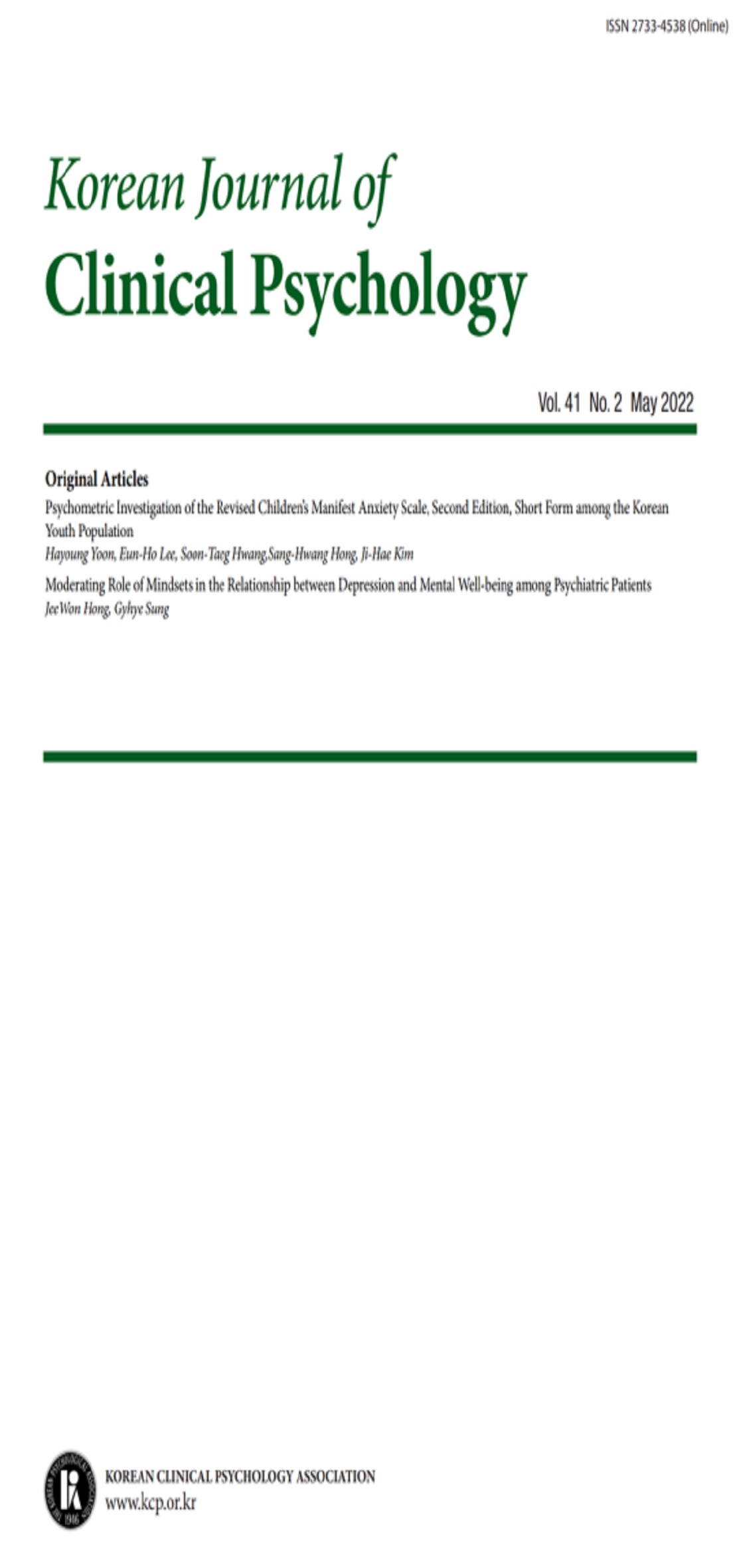open access
메뉴
open access
메뉴 E-ISSN : 2733-4538
E-ISSN : 2733-4538
This study investigated time perception in ADHD children. Twenty-seven ADHD children and twenty-five controls participated, and four tasks were administered to both groups, as follows: 1) A computerized time reproduction task (intervals of 3, 8, 13, 18, and 25 seconds, with or without distraction) to estimate time perception accuracy. 2) Neurocognitive ability tasks 3) A questionnaire for the parents to rate the time- oriented behavior of their children, including preparation and planning ahead for deadlines. 4) A questionnaire for the children to answer, which was to measure their time notion, including time orientation, sequence of time, ability to estimate duration of their daily activities, and ability to look back on their past or to anticipate their future. As the results of using 2(group)×2(distraction)×5(intervals) factorial design ANOVA, distraction effect was not different between the two groups. However, as intervals became longer, ADHD children became less accurate in time perception compared to controls. Time notion was not different between the two groups. However, time perception accuracy was related to their ability to estimate the duration of daily activities, as well as their ability to look back on their past or to anticipate their future. And ADHD children showed more difficulty in time-oriented behavior. These results indicates that temporal span in ADHD children is shorter than controls, which means they are temporal myopic. Deficit of time perception in ADHD children makes them have difficulty in preparing and planning ahead. The time perception accuracy is related to executive functions(divided attention, inhibition), working memory, and sustained attention. Time perception is not automatic process, but requires cognitive effort.
박경숙, 윤점룡, 박효정, 박혜정, 권기욱 (1991). KEDI-WISC 검사 요강. 한국교육개발원.
소유경, 노주선, 김영신, 고선규, 고윤주 (2002). 한국어판 부모, 교사 ADHD 평가 척도의 신뢰도와 타당도 연구. 신경정신의학, 41, 283-289.
신민섭, 구훈정 (2007). 아동 색 선로 검사. 서울: 학지사.
신민섭, 박민주 (2007). 스트룹 아동 색상-단어 검사. 서울: 학지사.
Barkley, R. A. (1997a). ADHD and the nature of self-control. New York: Guilford Press.
Barkley, R. A. (1998). Attention-deficit hyperactivity disorder: a handbook for diagnosis and treatment. New York: Guilford Press.
Barkley, R. A., Edwards, G., Laneri, M., Fletcher, K., & Metevia, L. (2001). Executive functioning, temporal discounting, and sense of time in adolescents with attention deficit hyperactivity disorder(ADHD) and oppositional defiant disorder(ODD). Journal of Abnormal Child Psychology, 29(6), 541-556.
Barkley, R. A., Koplowitz, S., & Anderson, T. (1997b). Sense of time in children with ADHD: Effects of duration, distraction, and stimulant medication. Journal of the International Neuropsychological Society, 3, 359-369.
Barkley, R. A., Murphy, K. R., & Bush, T. (2001). Time perception and reproduction in young adults with ADHD. Neuropsychology, 15(3), 351-360.
Brown, J. W. (1990). Psychology of time awareness. Brain and Cognition, 14, 144-164.
Charlesworth, R. (2005). Experiences in math for young children. Clifton Park, NY: Thomson Delmar Learning.
Corsi, P. M. (1972). Human memory and the medial temporal region of the brain. Dissertation Abstracts International, 34(02), 891B. (University Microfilms No. AAI05-77717).
D' Elia, L. F., Satz, P., Uchiyama, C. L., & White, T. (1996). Color Trails Test: Professional manual. Odesa, FL: Psychological Assessment Resources.
DePaul, G. J. (1991). Parent and teacher ratings of ADHD symptoms: Psychometric properties in a community-based sample. Journal of Clinical Child Psychology, 20(3), 245-253.
Fraisse, P. (1967). Psychologie du temps. Paris: Universitaires de France.
Fuster, J. M. (1989). The prefrontal cortex. New York: Raven Press.
Kaufman, A. S. (1976). A Four-Test Short Form of the WISC-R. Contemporary Educational Psychology, 1, 180-196.
McInerney, R. J., & Kerns, K. A. (2003). Time reproduction in children with ADHD: Motivation matters. Child Neuropsychology, 9(2), 91-108.
Meaux, J. B., & Chelonis, J. J. (2003). Time perception differences in children with and without ADHD. Journal of Pediatric Health Care, 17, 64-71.
Michon, J. A., & Jackson, J. L. (1984). Attentional effort and cognitive strategies in the processing of temporal information. Annals of the New York Academy of Sciences, 423(15), 298-321.
Quartier, V. (2009). Le développement de la temporalité: théorie et instrument de mesure du temps notionnel chez l'enfant(Temporality development: Theory and instrument to measure notional time in children). Approche Neuropsychologique des Apprentissages chez l'Enfant, 101, 76-85.
Quartier, V., Zimmermann, G., & Nashat, S. (2010). Sense of time in children with attention-deficit/hyperactivity disorder(ADHD): A comparative study. Swiss Journal of Psychology, 69(1), 7-14.
Quay, H. C. (1988). Attention deficit disorder and the behavioral inhibition system: The relevance of the neuropsychological theory of Jeffrey A. Gray. In L. M. Bloomingdale & J. A. Sergeant (Eds.), Attention deficit disorder: Criteria, cognition, intervention (pp.117-126). Oxford: Pergamon.
Reitan, R. M. (1979). Trail Making Test : Manual for administration and scoring. Tucson, AZ: Reitan Neuropsychological Laboratory.
Schachar, R. J., Tannock, R., & Logan, G. (1993). Inhibitory control, impulsiveness, and attention deficit hyperactivity disorder. Clinical Psychology Review, 13, 721-739.
Seo WS, Koo BH, Kim MJ, Rho YH, Sung HM, Shin JH. (2008). Preliminary Study of Children's Sleep Problems in an Elementary School in Daegu. J Korean Acad Child Adolesc Psychiatry, 19(3), 156-161.
Smith, A., Taylor, E., Rogers, J. W., Newman. S., & Rubia, K. (2002). Evidence for a pure time perception deficit in children with ADHD. Journal of Child Psychology and Psychiatry, 43(4), 529-542.
Tolpak, M. E., & Tannock, R. (2005). Time Perception: Modality and Duration Effects in Attention-Deficit/Hyperactivity Disorder(ADHD). Journal of Abnormal Child Psychology, 55(5), 639-654.
van der Meere, J., van Baal, M., & Sergeant, J. (1989). The additive factor method: A differential diagnostic tool in hyperactivity and learning disability. Journal of Abnormal Child Psychology, 17, 409-422.
Yang, B., Chan, R. C. K., Zou, X., Jing, J., Mai, J., & Li, J. (2007). Time perception deficit in children with ADHD. Brain Research, 1170, 90-96.
Zimbardo, P., & Boyd, J. (2008). The Time Paradox: The New Psychology of Time That Will Change Your Life. New York: Free Press.
